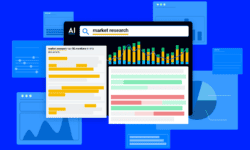Investment research can easily be the most exciting yet daunting task of the day.
The thrill lies in the potentiality that it could lead to new opportunities, strategies, or decisions. However, looming above that excitement is the weight of how much time it takes combined with the cold, hard reality that it could all yield little results.
Although there is no one “right way” to conduct research, there are a few best practices you can incorporate to make the process more efficient and fruitful.
- Meet yourself where you are
- Don’t get stuck on the numbers
- Take notes along the way
- Give yourself a timeline
- Leverage new sources
Define the Questions You Need to Answer
You rarely ever start research on a company or topic from complete scratch. Before blindly entering terms into your database or search engine, familiarize yourself with the information that has already been collected. There is no time for duplicative work, so it’s always better to build upon what already exists than to start from zero. After processing the information you’ve gathered, take a moment to formulate the important questions or jot down an outline of what you still need to know. Then, identify which sources would be the most helpful for your research.
Are you needing more information on an industry trend? Then narrow your sources to just industry reports. Are you conducting an analysis of the public’s perception of a company? Then just look at the news. This will allow you to get the answers you want more quickly by eliminating the noise in your search results.
Understand the Why Behind The Numbers
A steep increase in sales or a sharp decline in operating expenses might seem like good indicators, but don’t run to your MD without knowing the reasons for these changes.
Studying a company’s financials provides a good snapshot of its quarter, but understanding those numbers within the context of the company’s overall history and current events is key to conducting invaluable research. Leverage tools that make it easy for you to evaluate company performance Q/Q so you can establish a good baseline of their overall performance. Additionally, leverage features such as table extractors or Q/Q comparison tools that aid in better analyzing quantitative information.
By using the right tools, you can focus your energy on actually doing the analysis and coming up with a thesis instead of spending hours reading through reports or opening 5-years of financials.
Take Notes Along The Way
There is nothing worse than presenting your findings to your manager, only to have them ask for the source and you have no idea where it’s from. Skip the awkward silences or lag in responses by keeping your research organized. This will not only help you when you’re writing out assumptions for your model, but it’ll also provide you with a list of sources that you may find helpful the next time you research. Instead of using a sticky note or a google doc, utilize the Note functionality of your research tools to help keep all your sources in one place.
You can also annotate sections of a document and share it with your team with a click of a button. That way, you never have to spend another half hour of your time finding that one line in an 89-page document you skimmed a week ago.
Give Yourself A Timeline
It’s easy to get into a 6-hour rabbit hole researching one topic, but that’s not the best use of your time (unless maybe you’re a sell-side analyst). Shockingly, there is such a thing as ‘too much’ when it comes to investment research.
Your goal should not be to find as much information as possible but to find the right insights in as little time as possible. This goal can be achieved by doing your research in shorter intervals and evaluating your findings periodically. After doing this, refine your questions and revisit the topic with a fresh set of eyes. This will prevent you from focusing all your energy on one topic, or revisiting the same sources in an attempt to find something different.
Another way to stay efficient is to use tools that eliminate the manual and administrative parts of investment research. Don’t waste time combing through hundreds of pages with CLTR+F, or altering your key terms ever-so-slightly hoping to get different results. Should it really make a difference whether you type in “Tesla cost-cutting initiative” vs “Tesla expense cutting”? This is why we pride ourselves on our Smart Synonym technology to get you the best results in the least number of searches.
Leverage New Sources
Everyone has a few websites, subscriptions, and news publications that they consider their “go-to”. However, it’s likely that those sources are also being used across your team and considered a standard across the company. If your goal is to present insights that others have not found before, it’s time to find new reputable sources to aid in your research. Expert call libraries are a great way to leverage the expertise of professionals in the space without having to spend time sourcing or conducting the calls yourself. It’s also a great way to gut-check your assumptions and get a sense of what questions analysts are asking about the company or industry.
If you are short on time, you can get all the same benefits through an expert call transcript instead of listening in on the hour-long call. The AlphaSense investment research platform not only enables you to annotate the calls but overlays the same AI tools so you can conduct sentiment analysis on the calls as well.
Looking to streamline your workflows and speed up your time to reach alpha? Learn how to leverage AI and NLP to cut down on research time in our white paper, How AI is Shaping the Future of Investment Research.





